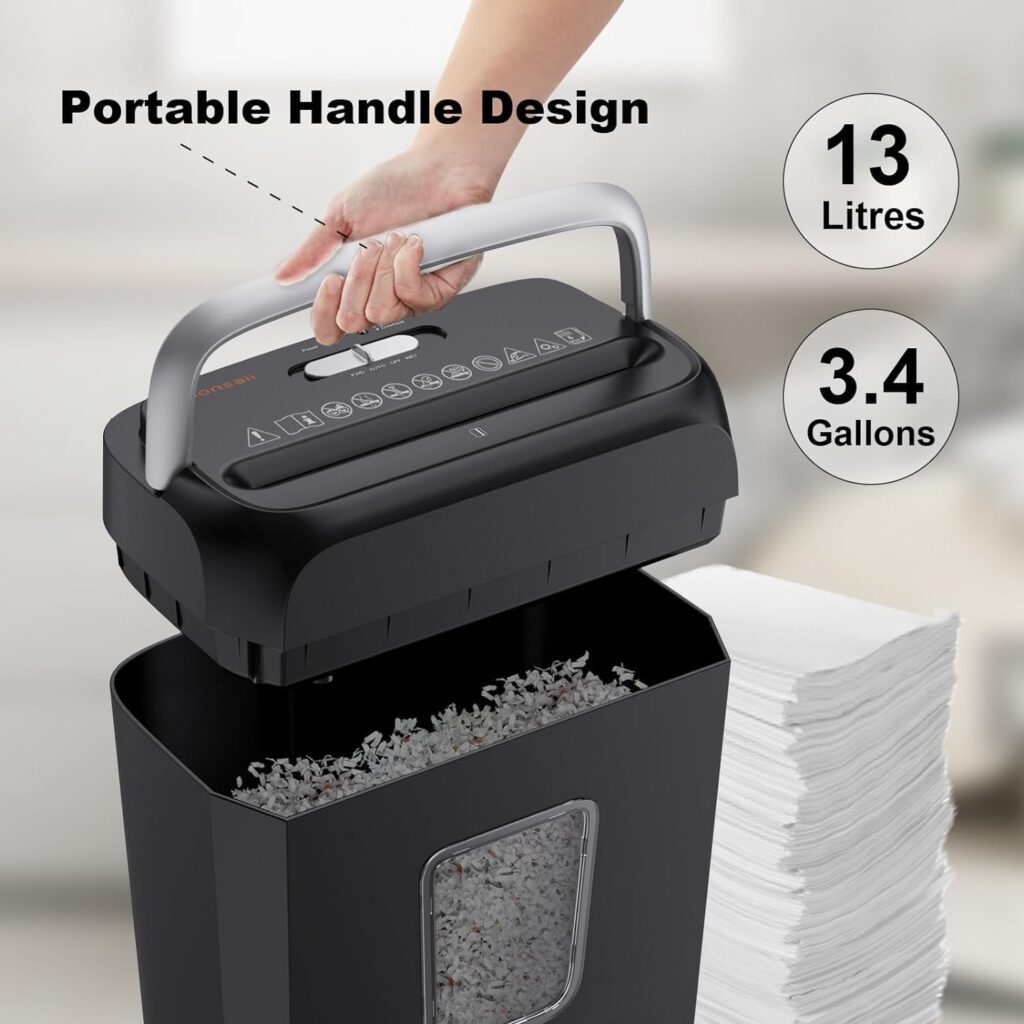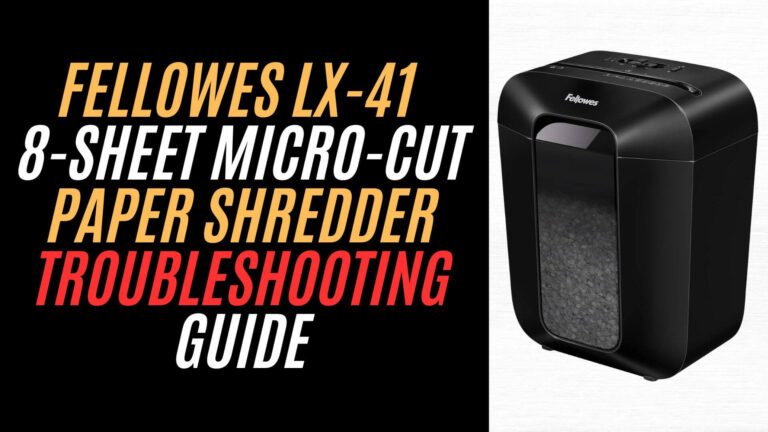The Bonsaii C237-B shredder is a dependable tool for securely disposing of sensitive documents, but its functionality heavily depends on the correct placement of its 3.4-gallon waste bin. Ensuring the bin is properly aligned is not just about operational efficiency—it’s also a crucial factor for maintaining safety and preventing issues such as misfires or overflow. Misaligned bins can disrupt the shredder’s operation by interfering with the safety sensors designed to detect the bin’s presence.
This guide provides validated insights into why proper waste bin alignment matters, the issues caused by misalignment, and step-by-step instructions to resolve or avoid these problems.

Why Is Proper Waste Bin Alignment Important?
- Activates the Safety Sensors: The Bonsaii C237-B shredder uses sensors near the bin slot to detect if the waste bin is securely in place. Misaligned bins can trick the sensors into stopping the shredder’s operation.
- Prevents Shredded Material Backup: An improperly seated bin can lead to shredded material backing up into the feed slot, potentially causing jams or motor strain.
- Improves Efficiency: Proper bin alignment ensures uninterrupted shredding sessions, saving time and reducing frustration during use.
Steps to Ensure Proper Waste Bin Alignment
Proper alignment of the waste bin in your Bonsaii C237-B shredder is crucial for ensuring smooth and uninterrupted operation. Below is an in-depth guide to correctly aligning the waste bin:
1. Turn Off and Unplug the Shredder

Before making any adjustments, always prioritize safety by turning off and unplugging the shredder. This ensures that the machine does not accidentally start during the alignment process.
- Locate the power switch on the shredder and turn it to the “OFF” position.
- Unplug the power cord from the wall outlet.
- Place the shredder in a stable, well-lit area to inspect and adjust the waste bin easily.
2. Remove the Shredder Head

The shredder head must be lifted off to access and adjust the waste bin properly.
- Hold the shredder head firmly by its sides.
- Lift it straight up, avoiding tilting or rotating the unit to prevent spillage of shredded material.
- Place the shredder head on a flat, secure surface to avoid accidental damage.
Pro Tip: If the shredder head feels heavy, ask for assistance to prevent dropping or mishandling it.
3. Inspect the Waste Bin
Ensure the bin is free of debris and correctly shaped for a proper fit.
- Empty the waste bin if it’s full. Overfilled bins can prevent proper alignment.
- Check for any cracks, warping, or irregularities in the bin that might interfere with its placement.
- Use a soft cloth to wipe away dust or debris from the bin’s edges and the base of the shredder.
4. Reinsert the Waste Bin Properly
A securely placed bin ensures the shredder’s sensors detect it and allow the machine to operate.
- Align the bin with the base of the shredder, ensuring the edges match the designated slot.
- Gently slide the bin into place without forcing it. A smooth fit indicates proper alignment.
- Push the bin firmly until you hear or feel it click into position.
Pro Tip: Check that there is no gap between the bin and the base of the shredder, as even small misalignments can cause operational issues.
5. Reattach the Shredder Head
The shredder head must sit flush on the waste bin to activate the sensors.
- Carefully lift the shredder head and position it directly over the bin.
- Align the shredder head with the bin’s edges, ensuring it sits evenly on all sides.
- Lower the head gently onto the bin, avoiding any tilting or misalignment.
Pro Tip: Ensure the shredder head does not wobble after placement; it should feel stable and secure.
6. Test the Alignment

Testing ensures the shredder is operational and the bin is correctly aligned.
- Plug the shredder back into the power outlet.
- Turn the power switch to the “AUTO” or “ON” position.
- Insert a single sheet of paper to test shredding functionality.
- Observe whether the shredder operates smoothly and whether the waste material is directed into the bin.
Pro Tip: If the shredder does not start, double-check the bin’s alignment and clean the sensors before retrying.
7. Monitor the Bin During Use
Frequent checks ensure the bin remains aligned during shredding sessions.
- Keep an eye on the bin’s fill level using the transparent window.
- Empty the bin before it reaches full capacity to avoid misalignment caused by overflowing shredded material.
Pro Tip: Develop a routine to check bin alignment after every shredding session for consistent performance.
Common Issues Caused by Misaligned Waste Bins
Misaligned waste bins in your Bonsaii C237-B shredder can lead to various operational problems, affecting performance and potentially causing long-term damage. Understanding these issues can help you identify and resolve alignment problems promptly.
1. Shredder Stops Working Unexpectedly
The shredder’s safety sensors are designed to detect the presence and proper alignment of the waste bin. If the bin is not aligned correctly, the sensors may interpret this as the bin being absent, causing the shredder to stop working.
This can interrupt shredding sessions and may leave you frustrated as the shredder appears non-functional, even though it’s in good working condition.
Solution:
- Remove the bin and clean the sensor area to ensure there’s no dust or debris interfering with detection.
- Realign the bin carefully, ensuring it fits securely in place.
2. Overflowing Shredded Material
A misaligned bin may create gaps between the shredder head and the bin, allowing shredded material to spill out. This can cause a mess and reduce the efficiency of your shredding sessions.
Overflowing material can clog the feed slot, increasing the risk of jams and motor strain.
Solution:
- Always ensure the bin is properly seated before starting the shredder.
- Monitor the fill level through the transparent window and empty the bin before it reaches full capacity.
3. Increased Risk of Jams and Blockages
When the bin is misaligned, shredded material may not flow freely into the bin. This can cause shredded pieces to back up into the feed slot, leading to jams.
Frequent jams can damage the blades, overheat the motor, and reduce the shredder’s overall lifespan.
Solution:
- Regularly check that the bin is aligned and positioned correctly.
- Clear any blockages immediately to prevent damage to the internal components.
4. Sensor Malfunction
Misaligned bins can lead to inaccurate readings from the shredder’s safety sensors. Dust or debris near the sensors may also compound the problem, causing the shredder to malfunction.
The shredder may fail to detect a properly placed bin, resulting in operational errors.
Solution:
- Clean the sensors regularly with a soft, dry cloth to remove dust and debris.
- Align the bin correctly to ensure the sensors detect its presence accurately.
Preventative Tips for Maintaining Proper Bin Alignment
Taking preventative measures can help you avoid the issues caused by misaligned bins, ensuring your Bonsaii C237-B shredder runs smoothly and efficiently.
1. Clean the Sensors and Bin Slot Regularly
Dust and debris can interfere with the shredder’s safety sensors, leading to alignment issues and operational errors.
- Turn off and unplug the shredder.
- Use a soft, lint-free cloth to gently clean the sensors located near the bin slot.
- Wipe down the edges of the bin and the bin slot to remove any accumulated dust.
2. Monitor the Fill Level
Overfilled bins can press against the shredder head, disrupting alignment and causing shredded material to spill out.
- Use the transparent window on the bin to check the fill level.
- Empty the bin before it reaches full capacity to prevent overflow and misalignment.
3. Inspect the Bin for Damage
A warped or cracked bin may not fit securely in the shredder, leading to alignment problems.
- Regularly check the bin for visible damage, such as cracks or bent edges.
- Replace the bin with an official Bonsaii replacement if you notice any damage.
4. Avoid Forcing the Bin into Place
Forcing the bin into the slot can damage the bin, the shredder’s base, or the alignment mechanism.
- Gently slide the bin into the slot, ensuring it fits snugly without resistance.
- If the bin doesn’t align properly, check for obstructions or warping before trying again.
5. Align the Bin Before Every Use
Regularly checking the bin alignment ensures the shredder is ready for operation and prevents issues during shredding sessions.
- Each time you empty the bin, reseat it carefully and ensure it’s properly aligned.
- Test the shredder in auto mode before inserting paper to confirm alignment.
6. Follow the Manufacturer’s Guidelines
Adhering to the guidelines in the Bonsaii C237-B user manual ensures you’re using the shredder as intended, reducing the risk of misalignment.
- Refer to the user manual for instructions on proper bin placement and maintenance.
- Avoid modifying the shredder or using incompatible bins, as this can void the warranty and cause operational issues.
FAQs
Why won’t my shredder work even though the bin is in place?
The bin may not be fully aligned or seated properly. Remove the bin, check for obstructions, and reinsert it securely.
How do the sensors detect the waste bin?
The Bonsaii C237-B uses sensors near the bin slot to confirm the bin’s presence. Misalignment can cause the sensors to fail in detecting the bin.
What should I do if shredded material overflows from the bin?
Turn off the shredder, empty the bin, and clean any debris from the base before reseating the bin.
Can I use a different bin for the shredder?
No, the shredder is designed specifically for its included waste bin. Using an incompatible bin may interfere with sensor alignment and functionality.
How often should I check the bin alignment?
Check the bin alignment every time you empty it or before starting a shredding session to ensure proper placement.
Conclusion
Proper waste bin alignment is essential for the smooth operation of the Bonsaii C237-B shredder. By following the steps outlined above, you can prevent operational errors, maintain efficiency, and extend the lifespan of your shredder. Regularly checking the bin’s alignment, cleaning the sensors, and adhering to the manufacturer’s guidelines will ensure your shredder remains a reliable tool for secure document disposal.



